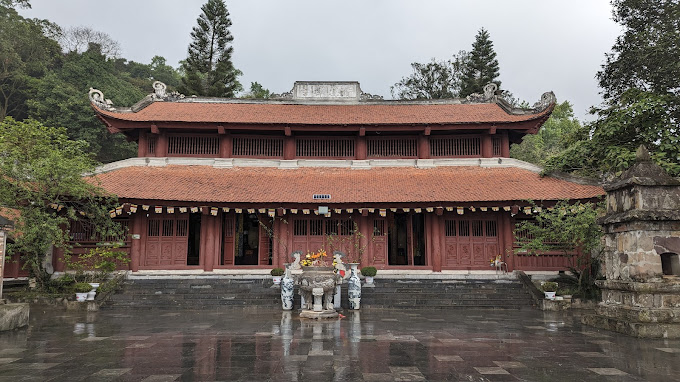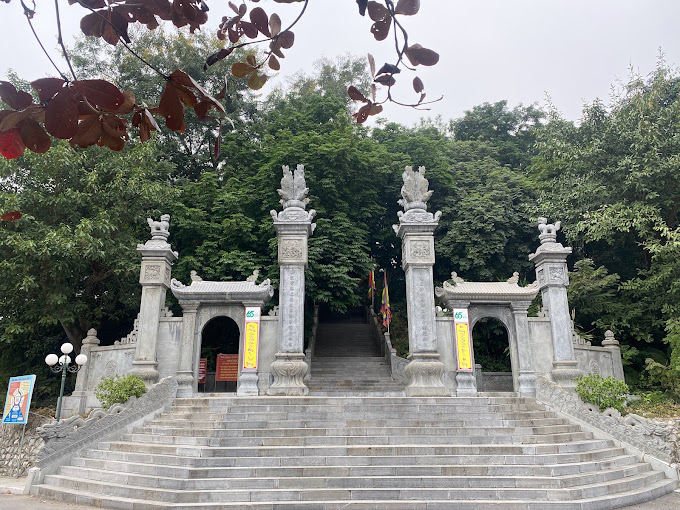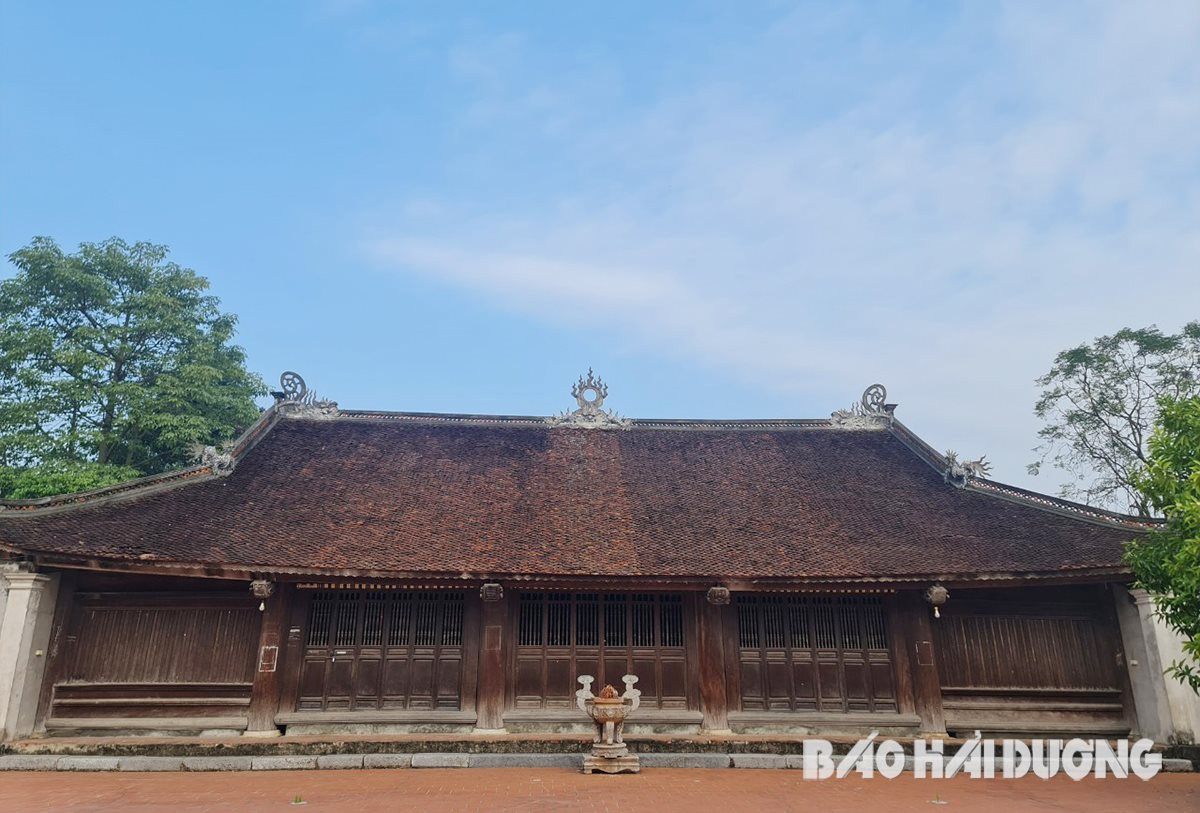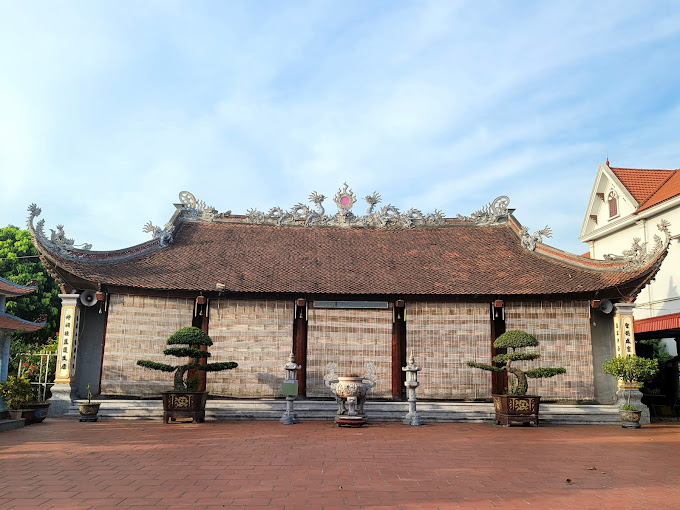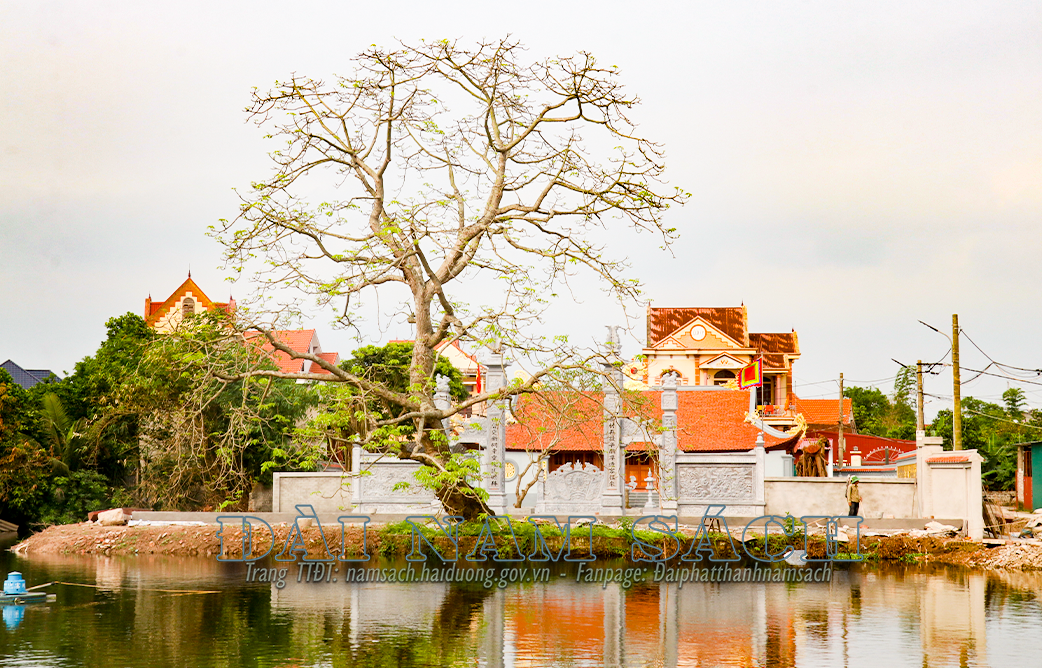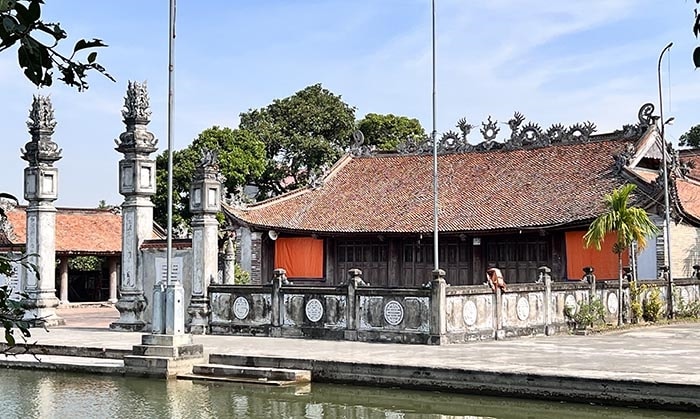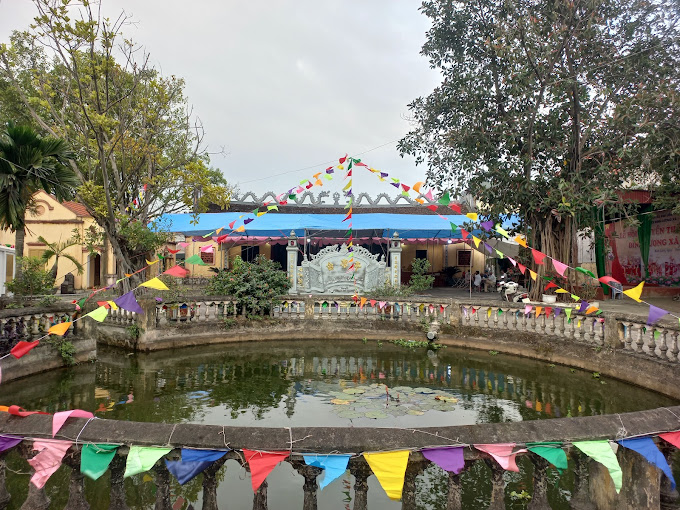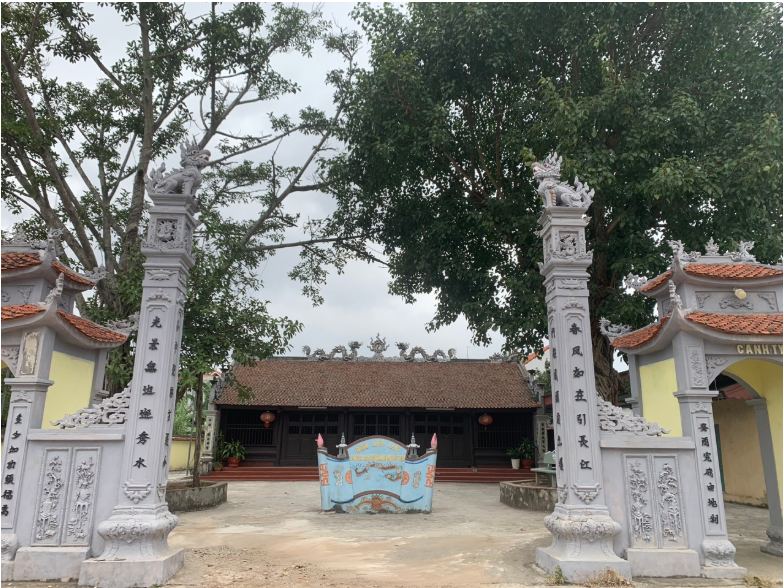Relic point Vietnam
Việt NamThanh Mai Pagoda
Thanh Mai Pagoda belongs to Hoang Hoa Tham commune. Thanh Mai Pagoda is a very ancient pagoda, built in 1329 by Zen Master Phap Loa - Second Patriarch of the Truc Lam Yen Tu Zen Sect. The pagoda was recognized as a national historical site in 1992. Thanh Mai Pagoda was built on a mountainside, next to a small stream, looking south. In front of the pagoda is Bai Vong Mountain where there is the grave of Nguyen Phi Khanh - Nguyen Trai's father. Currently, the pagoda is being partially restored on the remains of a large project including: 7-compartment front hall, 5-compartment Tam Bao, two corridors, ancestors' house, monk's house. Behind is Vien Thong tower, built in 1334. In front there are 7 towers. At the relic, there are 7 valuable steles, of which the Thanh Mai Vien Thong marble tower has the greatest value. It can be said that this is a national treasure. The stele talks about the life and career of the second patriarch of the Truc Lam Zen sect, but through it we can see the contemporary political, religious, and land situation and the activities of the third Truc Lam patriarch: Tran Nhan Ton. , Phap Loa and Huyen Quang. According to the epitaph: Phap Loa was originally Dong Kien Cuong, born on May 7, Giap Than year, the 6th year of Thieu Bao (1284), in Dong Hoa village, Cuu La village, Nam Sach Giang, now in Ai Quoc commune. Nam Sach district. In the year Hung Long 13 (1304), on the occasion of Tran Nhan Ton's visit to Cuu La village, Dong Kien Cuong came to worship. Nhan Ton realized that Kien Cuong was a man with a religious eye, meaning he had the ability to practice and attain enlightenment. He let Phap Loa follow him to study Buddhism and gave him a new name: Hy Lai, meaning one who brings joy. He was intelligent and studious and enthusiastic about Buddhism, so just one year later, he died as a Ky Unicorn. Chi Linh) he was given the dharma name Phap Loa by Dieu Ngu Dau Da Tran Nhan Ton. In February of the year Hung Long 15 (1307), Tran Nhan Ton gave Phap Loa the treasures. And on the first day of the first month of the year Hung Long 16, he handed over the right to inherit the career of the Truc Lam Tam To Zen sect. From then on he became the second founder of this Zen sect. On the 5th day of the second month of the second year of Khai Huu (1330), Phap Loa was preaching sutras at An Lac hospital when he suddenly fell ill. On the 13th, the monk returned to Quynh Lam Institute (Dong Trieu) to recuperate. On day 19, the illness became severe. Seeing that it was difficult to survive, Phap Loa invited Huyen Quang to give him the treasures that Tran Nhan Ton gave him 22 years ago before his death, such as robes, verses describing the mind... and said: "Huyen Quang will be the guardian." maintain and inherit". On the night of March 3, Phap Loa passed away at Quynh Lam Institute. According to the monk's will, his relics were placed in the tower behind Thanh Mai pagoda. Emperor Tran Minh Tong wrote in his pen, naming the monk Tinh Tri Venerable and the tower name Vien Thong, gave 10 taels of gold from the treasury to build the tower, and wrote an emotional poem of tribute. This is a rare grace in Vietnamese history. Since then, the career of the Truc Lam Zen sect was presided over by Huyen Quang and became the third patriarch of this Zen sect. Huyen Quang served as the Abbot of Thanh Mai Pagoda for 6 years. Thanh Mai Pagoda is a religious center of the Truc Lam Zen sect in deep forests and high mountains. The presence of the relic has proven the extraordinary nature of Tran Dynasty religion. There is also an ancient forest planted by humans in the middle of nature, a system of valuable towers and inscriptions, typically the stele "Thap Vien Thong". Therefore, the relic site and natural forest have been zoned for protection by the state, gradually restored and embellished to preserve a cultural heritage, creating an attractive tourist attraction in terms of culture and landscape. nature. The anniversary of Phap Loa's death has become an annual pagoda festival. The festival starts from March 1 to March 3. Source Electronic information portal of Chi Linh city, Hai Duong province.
Hai Phong 2893 view
Cao An Lac Temple
Cao Temple belongs to An Lac commune. There are four ancient sacred temples here, worshiping the five brothers of the Vuong family who helped King Le Dai Hanh defeat the Song army led by Hau Nhan Bao and Ton Toan Hung in 981. The temple is a cultural site, historical relic, and famous landscape of our country. Cao Temple worships 5 Vuong brothers named: Vuong Minh, Vuong Hong, Vuong Xuan, Vuong Thi Dao, Vuong Thi Lieu who fought against the Song invaders in the 10th century. The temple was built according to the architecture of the word "nail" located on Thien Bong mountain. Surrounding the temple is an old ironwood forest. Near the relic there is a bamboo forest where storks reside in large numbers, creating a lively landscape. This was once Le Hoan's military base during the resistance war against the Tong in 981. The temple was built in the pre-Le period, the relics are still being restored in the Nguyen dynasty, in a three-letter style, on a small scale. The architecture and sacrificial items are still quite consistent, typically the system of parallel sentences and great characters. This is a long-standing devotional center of local people. Every year there is a festival from January 22 to 25. The relic has the following works: pre-sacrifice, middle-class and post-harem works; There are many valuable antiques such as inscriptions, dragon swords, precious bowls, thrones, etc. Especially the system of great characters and couplets praising the merits of the 5 Vuong brothers and the nation's victorious resistance war against the Song army. When climbing over 100 mossy brick steps, visitors will see 99 elephants. made of stone. According to legend, these are elephants that have just returned from victory. They roared with their trunks and rushed down to the soft Nguyet Giang river to drink water. In the main hall, there is a great script written in stone style with four large cursive letters "Thanh Tho Vo Cuong", on the left "Cao Son Nguong Tu" and on the right "Cao Cao Tai Thuong". In front of the temple door, under the canopy of an ancient ironwood tree, are two rows of stone elephants and stone horses. In addition, Cao Temple is also a temple with a quite unique architectural style. Cao Temple is a meeting place for those who respect the nation's cultural history. Cao Temple worships General Vuong Duc Minh, who was instrumental in fighting the Song invaders. The project belongs to the Cao Temple relic complex worshiping the 5 Vuong brothers, and was ranked national by the State in 1988. Source Electronic information portal of Chi Linh city, Hai Duong province.
Hai Phong 3046 view
Bo Duong Communal House
Bo Duong communal house, Hong Phong commune, was built during the Le dynasty, Chinh Hoa era, over 300 years ago. The communal house is called Dinh Dong "East facing communal house" located in the center of Bo Duong village, Hong Phong commune, and is one of the three remaining communal houses in the ancient temple architectural complex of the Village. The communal house was built in the year Ky Ty (1689) of the Le dynasty, the reign of Chinh Hoa, the Dong communal house has the shape of the letter Dinh (J), the architecture is in the style of a traditional belt communal house in the Northern Delta, structured with a system of pillars. , bunk, truss bed, massive boat, including harem, ancient prize and 5 great worship rooms, low-slung roof, roofed with funny-nosed tiles, wooden pavilion covered with dragons flanking phoenixes, in the middle of the roof are 2 cows. Nghe, the roof of the communal house are two Lac dragons expressing the majestic power of creation. From a distance, the roof of the communal house looks as elegant as a kite taking flight; The interior of the pavilion has many pieces of delicately carved art on wood: Dragon, Ly, Quy, Phuong, Pine, Plum, Chrysanthemum, bamboo with philosophical features like a mother dragon teaching her children; Describes Village festival scenes such as: water puppetry, bowing, wrestling, boat racing... and many precious worship objects such as: thrones, war horses, octagons, lacquered and gold lacquered couplets. Bronze bells and many other worshiping objects have historical connections. In front of the communal house is a large yard, on both sides there are 14 banquet spaces, adjacent to the communal house in the front are the east tru and west tru gates; Entering the communal house yard through three gates including: the main gate, two gates on the left and right, the corner parallel to the three gates is two soaring pillars, on top covered with leaf buds that look like a giant pen writing poetry into the blue sky. The architectural complex of communal houses, temples, and temples in Bo Duong village is ancient and magnificent, one of the most magnificent in the region. But due to historical events, the weathering process caused a lot of loss. In 1993, with financial support from the state and contributions from local people, the communal house was restored and repaired. In 1995, Bo Duong and Hong Phong communal houses were decided by the Ministry of Culture and Information. decided to rank it as a National Historical and Cultural Relic. In 2010, the state supported over 10 billion VND and Bo Duong communal house continued to be restored and embellished. In 2011, the Department of Culture and Sports of Hai Duong province supported the locality to restore the ancient traditional festival, thereby serving as a basis for the people of Bo Duong village, Hong Phong commune, to preserve and promote the values culture at monuments. According to legend, the communal house worships General Cao Xuan Huu in Tam Hoang Village, Sieu Loai district, Thuan Thanh district (ancient name is Thuan An, Kinh Bac religion), he was born on the 13th of the first month in the year of Giap Ty, belonging to a family of virtuous people. core. Mr. Cao Xuan Huu is a talented man. Since he was a child, his parents sent him to pursue a university degree. He is famous for being intelligent and good at literature and martial arts. When his parents passed away, at that time in the 18th Hung Due Dynasty, at an old age, the king gave birth to 20 princes and 6 princesses, all of whom were immortal, intending to cede the throne to his son-in-law, Son Thanh, in the court. There was a General of the Thuc family who rebelled and asked for help from a neighboring country, intending to usurp the throne. Mr. Cao Xuan Huu went to help the King suppress the bandits. He was a talented man and was appointed by the King as a striker and general in command of the envoy. He and his soldiers were stationed in Bo Duong and Hong Phong and from there spread out everywhere to suppress the enemy. Wherever the troops went, the enemy dispersed. The country returned to peace. On the occasion of his trip, he visited his old place of Hong Chau. On the 13th day of the third lunar month, he held a party to celebrate the victory "Song of Triumph" and then passed away in Bo Duong, Hong Kong. Phong on November 12 (lunar calendar). General Cao Xuan Huu was bestowed by the King with the title: "Linh Ung the King conferred the title of Duong Dinh Linh Ung Pho Huu, Propaganda, Trach Chieu Thong, Resolute, Brave, Heroic, Protector of the Nation, Mighty, Talented, and Strategic, Superior Deity". The edict allows Bo Duong village, Hong Phong commune, to establish a temple to worship the gods and enjoy blessings with the country as a permanent ritual in the future. Since ancient times, every spring on the 13th day of the 3rd lunar month, remembering the day of his "Triumph Song", the Village people have had the custom of holding a festival to celebrate: carrying palanquins, offering sacrifices to pray for the country and people. peace, favorable weather, lush vegetation, good harvests, and a warm home. The village festival also has many fun activities such as: cheo singing, dum singing, lighting fireworks, hitting clay fireworks, cockfighting... most especially the water puppet show. Bo Duong Communal House Cultural and Historical Relic was built in a central location in the middle of Bo Duong village with an architectural complex and a campus of 1783.1 m2. The communal house faces East. In front, there is the main inter-village road running through and there is a Water Puppet House. The southeast is adjacent to the house displaying puppet shows and the village's central Cultural House. The west borders the residential area. To the north is a large pond, which was also a place for water puppetry in ancient times. Source Electronic information portal of Ninh Giang district, Hai Duong province.
Hai Phong 2890 view
Ca Communal House, Tan Huong Commune
Dinh Ca is located in the center of village 5, Tan Huong commune, Ninh Giang district, Hai Duong province. Tan Huong is a land deposited by alluvium from the Red and Thai Binh river systems, so the land is fertile and convenient for agricultural production. According to legend in Nhan Dan, Ca communal house has been located at the same location since its inception, however there has been a change in the scale and space of the monument. Previously, the relic was surrounded by a residential area, behind was a communal pond, and in front was a residential road. Today there are changes compared to before: The East is adjacent to a residential area; The West and North border the inter-village road; The south borders the residential area. During the years of resistance against the US, Ca communal house was the place where the delivery and receipt of troops to serve the Southern battlefield took place. In the years 1957 - 1958, this place organized and implemented the popular education movement. "Popular education" is a movement to eliminate illiteracy among the entire population, launched by the Provisional Government of the Democratic Republic of Vietnam on September 8, 1945 (Decree 19/SL and 20/SL). Right after Vietnam gained independence, this movement solved "Ignorance" - one of Vietnam's most urgent problems at that time. Based on the legend - the spirit of ancient Nam Boi village (today separated into two villages: Village 3 and Village 5), Dong Boi canton, Ninh Giang district, Hai Duong province, compiled by Nguyen Binh Phung in the year of Hong Phuc. (1572), currently kept at the Institute of Social Science Information under the Vietnam Academy of Social Sciences, said: Dinh Ca, village 5, Tan Huong commune, Ninh Giang district, Hai Duong province is a place to worship 7 the Tutelary God including: 4 are human gods, 2 are angels and 1 is an earth god. The gods include: Quy Minh Dai Vuong, Phan Trac Mai Vy, Pham Mai Chinh Thien and Phan Mai Khai Quoc. The angels include: Thien Hoang Linh Thuong Great King, Thien Quan Hanh De Great King. The earth god is: Earth Spirit Great King. The Village Tutelary Gods are people who have contributed to helping the people and the country. Through many feudal dynasties, they have been awarded ordained and established communal houses to worship. - Before the August 1945 Revolution: At the relic, two festivals take place: From the 5th to the 15th of the 11th month (lunar calendar): This is the main festival of the year - Tutelary God's Transformation Day; On the 2nd day of the first month (lunar calendar) and the full moon day (lunar calendar) of every month, the monument is open for people and tourists to offer incense. + Main festival - Tutelary God's Transformation Day: Takes place in 10 days, starting from the 5th to the 15th of the 11th month (lunar calendar), (in which the 5th and 6th are the main festivals). During the festival, activities take place such as: Organizing the "Ong Pig" contest, the procession of the Holy Set is held solemnly and solemnly. The procession departs from the Ca communal house, the procession goes to the North temple, then organizes incense offerings here, after offering incense, the procession continues to the East temple, the procession to the Nam temple, then the procession returns to the communal house. During the days of the festival, in addition to the sacred and solemn ceremony. The festival is exciting, organizing many forms of participation in games such as: Chess; Cockfighting; Praying for ducks, catching ducks; Earthen artillery; Wrestling; Tug of war... + January 2 (lunar calendar): In addition to the main festival on the 5th and 6th of the 11th month (lunar calendar), every year on the 2nd day of the New Year, a market is held at the communal house yard - this is a typical event of the Tan Huong people. It has become a custom that on the 2nd day of Tet, people in Tan Huong commune gather at Ca communal house to hold a market to pray for good luck. Each year the market only holds one session. People come to the market, in addition to buying and selling, they also go to the village communal house to burn incense to pray for luck and happiness throughout the year. - Today's festival: In recent years, the organization of festivals at Ca communal house has been organized by the Commune People's Committee. The festival is held for 3 days: From the 5th to the 7th of the 11th month (lunar calendar). Source Electronic information portal of Ninh Giang district, Hai Duong province.
Hai Phong 2780 view
Tran Xa communal house
Tran Xa village communal house, Nam Hung commune (Nam Sach) has a long history, is the place to worship 3 Tutelary Gods of the Pham family during the Ly dynasty and worship the famous general Tran Quang Khai - a man who had great contributions to contribute to the victory of the Tran dynasty's army and people. victory in the resistance war against the Mongol invaders in the 13th century. The communal house has been ranked as a provincial historical relic since 2007. However, due to the deterioration of the building, it has received attention from all levels, and according to the wishes of officials, party members and people. , Tran Xa communal house has been renovated and renovated. Tran Xa is a famous historical place. During the Ly Dynasty, Tran Xa was called Tran Xa Trang, located on the left bank along the Kinh Thay River, creating a large area called Tran Xa pool. During the Tran Dynasty, the Tran Xa site was changed to Tran Xa loan. Legend has it that in 1282, King and I of the Tran Dynasty returned to this area to hold a conference in Binh Than to discuss plans to fight the Mongol invaders for the second time. Today, in the Khoai No pile of Tran Xa village, there are still 2 doi trees. Legend has it that this is where the king lived. Tran Dynasty mandarins tied their horses when getting off the boat to hold the Binh Than conference. These two trees are conserved and preserved by the people and are recognized as heritage trees in 2021. Tran Quang Khai (1241-1294) was the third child of King Tran Thai Tong, his mother was Queen Ly Thi Thuan Thien (eldest daughter of Emperor Ly Hue Tong). He is the younger brother of Crown Prince Tran Hoang, also known as King Tran Thanh Tong. In 1258, King Tran Thanh Tong appointed him the title of Lieutenant, Chieu Minh Vuong and ruler of Nghe An province. In Thieu Long's 14th year (1271), he became a lieutenant-general and became the head of the court in charge of state affairs. In the 4th year of Thieu Bao (1282), King Tran Nhan Tong promoted Tran Quang Khai to the position of Senior General and Grand Master, holding full power over internal affairs. He was a politician, military man, and a member of the Dai Viet royal family during the Tran dynasty. Legend has it that when King Tran Nhan Tong returned to open the Binh Than conference in Tran Xa area, Tran Quang Khai was assigned the responsibility of general commander to protect and keep the conference secret. After his death, to commemorate the talented general, the people of Tran Xa site (Tran Xa loan) set up a temple to worship and burn incense forever. Tran Xa Communal House was built in the Later Le Dynasty on a high mound in the middle of the village. At the same time, the people brought Grand Master Tran Quang Khai to worship at the communal house along with the three village tutelary gods. During the Nguyen Dynasty, the communal house was restored and was spacious and beautiful, including 5 main worship rooms and 3 back palace rooms made of four-iron wood. In 1953, the great hall was demolished by the French colonialists, leaving only 3 harem rooms remaining. Through the changes of time, the harem was damaged and was restored by the people in 1992. In 1999, 5 great worship rooms continued to be restored. In 2007, Tran Xa communal house was recognized as a provincial cultural and historical relic. Overcoming the changes and ups and downs of history, Tran Xa communal house still retains a number of valuable antiques such as a 12th Chinh Hoa stone stele (1691); 1 altar throne, 1 altar sword, 1 coffin, 1 incense bowl of Phu Lang ceramic of Nguyen Dynasty (19th century). Up to now, some items such as Tien Bai House, courtyard, and communal house walls have seriously degraded. Based on the actual situation and according to the wishes of the people in the village, Nam Hung commune proposed and was allowed to restore the monument. Up to now, the project of restoring and embellishing Tran Xa communal house has been completed. The unique and impressive feature of Tran Xa Communal House when renovated is the relief of the 13th century Tran Dynasty village painting, with images of Luc Dau Giang branch, Ben Binh Than Conference, banyan tree, and well. , communal house yard, hero Tran Quoc Toan with a flag embroidered with six golden words "Destroy the enemy's strength, report to the king's grace", two duoi trees - where the Tran dynasty's kings and mandarins tied their horses when getting off the boat to hold the Binh Than conference... Tran Xa village communal house was renovated and renovated to be spacious and beautiful, meeting the wishes of the people of Tran Xa village in particular and the people of Nam Hung commune in general. This is the bond that unites the community and the beauty of village culture. In the minds of Vietnamese people, "banyan tree, water wharf, communal house yard" are familiar images, attached to the souls of all people, a symbol of homeland and country. Source: Electronic information portal of Nam Sach district, Hai Duong province.
Hai Phong 2844 view
Nghe Coc Village Pagoda
The Gia Coc Pagoda relic cluster is located on flat, high land, running from Northwest to Southeast, in Gia Coc village, Tu Cuong commune, Thanh Mien district, Hai Duong province. According to the Chinese legend copied by the Minister of Rites Nguyen Hien on the king's orders in the year of Thuan Thien, the third year of the eighth month, the first three days (August 3, 1430) and left at the relic, it is said that in the past, The cluster of relics and Gia Coc pagoda (currently the cluster of relics is located in Gia Coc village, Tu Cuong commune, Thanh Mien district, Hai Duong province) is located on an area of land with unusually beautiful scenery, running from Northwest to Southeast , in front there is a pile of golden turtles as a project; Behind the converging tides, on the left there is a dragon, on the right there is a tiger, behind there is an elephant. Currently, although the landscape of the relic complex has changed a lot, it still retains many characteristics from ancient times. And according to folk beliefs, the Neo river branch running from Northwest to Southeast of Gia Coc village is the image of a dragon. Many mounds in front of the monument are traces of golden turtles and tigers. Historical sources say that during the Ly dynasty, Gia Coc village was called Gia Coc site. Later changed to Gia Coc commune, Phu Me district, Thanh Mien district, Hai Duong province. After the August 1945 Revolution, it was changed to Gia Coc village, Tu Cuong commune, Thanh Mien district, Hai Duong province as it is today. The cluster of relics and Gia Coc Pagoda are associated with the name of a Ly Dynasty mandarin named Le Trung Hoa. He was born on March 10 and died on August 10 (year unknown). From a young age, he had great ambition and was perfect in literature and martial arts. At that time, the Song invaders sent their general, Hoang Phuc, to bring troops to invade our country. The court appointed Le Trung Hoa as Grand Master to command 10,000 troops to fight the Song invaders. At this time, the Song army was stationed in Hai Duong town. Grand Master Le Trung Hoa commanded the army to attack the East side and support the West side. The enemy army was defeated, the country was peaceful again, he brought his troops back to Gia Coc site to reward the soldiers. At Gia Coc site, seeing the unusually beautiful scenery, he decided to set up camp and station his troops here. After his death, the court provided money to build communal houses and temples for worship and he was granted the title of "Supreme God" by the dynasties and titled "Great King and Grand Master". He was honored by the people here as the Village's Tutelary God and had a statue made for worship. Currently, at the cluster of relics, there are still 5 decrees conferred by King Tu Duc in the 6th year (1853) on November 10; King Tu Duc in his 31st year (1878) conferred the second title; King Dong Khanh in his 2nd year (1887) conferred on July 1; King Duy Tan's 3rd year (1909) was conferred on August 11; King Khai Dinh in his 9th year (1924) conferred the title on July 25. Nghe Coc is made in the shape of the letter Nhi, the outer part has 5 rooms and the harem has 3 rooms, the rafters are all made in the style of the husband's children, the heads of the husband's children are carved with the theme of four sacred animals, the ends of the porch levers are carved. four-quarter engraving. Inside the harem there are 3 altars, on the left worshiping Tran Hung Dao, in the middle worshiping Le Trung Hoa and on the right worshiping Pham Ngu Lao. Next to Gia Coc Pagoda is Gia Coc Pagoda with Dinh-shaped architecture including a 5-compartment front hall and 3-compartment Tam Bao... With unique historical, architectural and artistic values..., the Gia Coc Pagoda and Pagoda relic complex was granted Decision No. 281 by the Ministry of Culture and Information (now the Ministry of Culture, Sports and Tourism). Certificate of recognition of the Gia Coc Pagoda relic cluster as a national historical-cultural relic cluster on April 14, 1993. Source Electronic information portal of Thanh Mien district, Hai Duong province.
Hai Phong 2491 view
Dinh Dao Lam
Dao Lam Communal House worships four generals: Pham Van, Hoang Cong Binh, Vu Cong Tao and Crown Prince Ly Manh. All four men were instrumental in helping the Ly dynasty drive out the Luong invaders. According to the legend preserved at Dao Lam communal house, in the 6th century, the Liang Dynasty in China sent General Tran Ban Tien to bring troops to invade our country. Upon receiving the news, King Ly Nam De immediately gathered his court officials to find a plan to fight the enemy and recruit troops. Because of their talent in literature and martial arts, Messrs. Pham Van, Hoang Cong Binh, Vu Cong Tao, and Crown Prince Ly Manh were trusted by the king to entrust 2,000 soldiers to fight the enemy. When he arrived at Dao Tong village, Gia Phuc district, Thuong Hong district (now Dao Lam village, Doan Tung commune), he was happily welcomed by the people. Seeing that this place had beautiful scenery and beautiful people, the four men ordered the soldiers and villagers to set up a palace and hold a feast to welcome the army. That day, there were 20 young men in the village who asked to fight the enemy. A few days later, the army quickly set out straight to the banks of the To Lich river to fight the enemy. With their ingenuity, the army of four quickly repelled the enemy. Unwilling to lose, the Luong army asked for more reinforcements. In the second battle, due to the difference in forces and weapons, many of the four soldiers died. To complete the relationship with the young country, all four generals threw themselves into the To Lich river on the 20th day of the 10th lunar month. After the battle, some surviving soldiers returned to Dao Tong village and told the story. To commemorate their gratitude, Dao Tong villagers built a temple to worship the four people at the palace that the insurgent army established in the past (now the harem of Dao Lam village communal house). With great merit, the Ly Dynasty immediately conferred the title of Superior God on all four generals. King Ly ordered the people of Dao Tong village to bring the king's beautiful statue to the temple of the four kings. In 1288, O Ma Nhi and Thoat Hoan brought 500,000 troops to invade the Tran Dynasty. King Tran Nhan Tong assigned the National Registrar Tran Quoc Tuan to the temple of four people in Dao Tong village to worship and pray. Then he went to fight the enemy and won a glorious victory. In 1416, King Le Thai To chased away the Ming Dynasty and also went to the temple of the four monks to worship and pray and indeed won. Thanks to that, the Tran and Le dynasties both conferred the title of Superior God for four people. Dao Lam Communal House is located on flat, spacious land and was built on a fairly large scale. The communal house consists of three main buildings: the outer communal house, the middle communal house and the rear palace, in addition there is a bell tower. Over time, the communal house has been tinged with moss and has many ancient features. The outer communal house has 5 rooms and 2 wings with an area of over 250 m2 with 4 rows of large ironwood columns. The architecture of the rafters is in the style of stacking lotus mats and carved with stylized flowers and leaves. The husband's heads are shaped like dragon heads. At the 8 ends, the image of a poisonous dragon holding a jade is carved, creating a solid position and expressing sacredness. The outer roof of the communal house is covered with roof tiles, the corner blades are shaped like a softly curved dragon's head. On the roofs are arranged four sacred animals (dragon, lyre, tortoise, phoenix). At both ends of the roof of the communal house are two strong dragon heads with a plier-like posture to keep the communal roof more stable. The middle communal house is 2 m away from the outer communal house and also includes 5 rooms and 2 wings but the area is smaller (about 220 m2). The most outstanding architecture is the carved art at the ends of the traps with the theme of four seasons: spring, summer, autumn, and winter. On the murals are very sharp and lively long pants. On the central crossbar hangs the great inscription "Duc Phong Thuong Thuong Than". Below are arranged 1 set of bowl-shaped palanquins, 2 sets of dragon palanquins. On both sides are two rows of eight-precious dragon swords. All artifacts are painted. Like the outer pavilion, the middle pavilion was built in the Later Le dynasty and renovated in the Nguyen dynasty. Next is the middle pavilion, which is about 105 square meters wide and includes three back rooms At the back of the harem there is a large altar with four thrones to worship the four village tutelary gods. Each throne has a tablet with their names written on it. In March 1990, Dao Lam communal house was ranked by the State as a national historical and cultural relic. Source Electronic information portal of Thanh Mien district, Hai Duong province.
Hai Phong 2702 view
Luong Xa Communal House
Luong Xa Communal House worships Mr. Dao Nha, who was instrumental in helping the Tran Dynasty fight against the Mongol invaders in the 13th century; His merits have been recorded in the legends, ordinations, and couplets that still exist and are kept at the monument. The communal house also worships Mrs. Tran Thi Huong, a supporter of the Can Vuong movement against the French at the end of the 19th century. Luong Xa communal house was built in the late 19th century and majorly restored in 1930. The architectural relics are quite consistent from the Great Temple. , Harem and Giai Vu, is a large-scale relic, with many carvings and reliefs of high artistic level. With this architectural style, it helps us study the history of ancient Vietnamese sculpture. Based on historical values, in 2001, Luong Xa communal house was recognized by the State as a national historical relic. For the locality, Luong Xa communal house is not only a place to worship people who have contributed to the country, it also marks the resistance war against the French and the Americans. It is a place that leaves a strong mark on culture and village beliefs. Researching the history of Luong Xa communal house relics brings us valuable resources in understanding the customs, traditions, and beliefs of the Vietnamese people. The festival has a sacrificial procession according to the long-standing custom of the local people and is held on March 8 (lunar calendar). Currently, the Festival has been completed by the Department of Culture, Sports and Tourism with its Profile and Festival script and has been organizing the Festival according to the script since 2014. Source Electronic information portal of Kim Thanh district, Hai Duong province.
Hai Phong 2620 view
Kien Lao Communal House
Kien Lao Communal House, also known as Xuan Quang Communal House. Kien Lao Communal House worships two gods who contributed to the country in the 10th century: Dao Cong Chieu and Dao Cong Hien. Kien Lao Communal House is located on a cool plot of land with the shape of a dragon flanking a tiger. Surrounded by bright green rice fields and shady trees, the communal house has an ancient and quiet look. Nguyen architecture, main side facing south, overlooking the rice fields near the village. The imposing three-entrance gate (renovated by the local government and people in 1992), the main gate rests on two pillars, with a double roof on top, and the two side gates are built with two overlapping roofs. The communal house is built in the shape of the letter Dinh (丁) and includes 5 front rooms and 3 back rooms. The roof is tiled, on the roof are two pincers, in the middle of which there is an image of two dragons flanking the moon. The two front gables and the back gables are embossed with tiger talismans. At the side door of the harem, there is also the words "Dong Khanh, the first year of the year, the year of the Dog, the first month, the first month, the first day, the first day, the first day of the year when the commune restored it," clearly showing that the communal house was built in 1886, restored in the 3rd year of Bao Dai's reign (1928). ) The main palace is decorated with hammock doors, on both sides are hung parallel sentences and placed a set of painted and gilded octagons. In the forbidden palace, there are two thrones and two bright red and gilded palanquins of the two Tutelary Gods The village also has an altar to worship Tran Hung Dao. This place still preserves 2 genealogies and 12 decrees conferred by the Le and Nguyen dynasties on the two village Gods and many valuable antiques and worship items such as: The altar of the Nguyen Dynasty, 3 great paintings, 3 parallel sentences, 3 incense burners of the Nguyen Dynasty... In front of the three-entrance gate, there is a yard more than a hundred square meters wide, with a green stone pillar as a flagpole next to the surface of a semi-circular lake about 500 meters wide. square meter. Cool and harmonious landscape, good feng shui. Based on historical values, in 1995, Kien Lao Communal House was recognized by the State as a national historical relic under Decision No. 2223-VH/QD dated June 26, 1995. The annual festival is held on November 15 (lunar calendar). There is a very special custom of worshiping gods and processions imbued with traditional culture that is admired by people and tourists. Currently, the Festival has been completed by the Department of Culture, Sports and Tourism with its Profile and Festival script and has been organizing the Festival according to the script since 2012. Source Electronic information portal of Dai Duc commune, Kim Thanh district, Hai Duong province.
Hai Phong 2781 view
Muong Pagoda (Quang Khanh Tu)
Muong Pagoda (Quang Khanh Tu) in Ngu Phuc commune is a major religious center of Kim Thanh district, Hai Duong province. The pagoda has experienced 7 centuries of existence, recorded in the history of Vietnamese feudalism. In addition to its rich history, Muong Pagoda is also known as the pagoda with the most towers in Hai Duong province. Having gone through the devastation of the war, the pagoda still retains a rather massive system of stone towers from the Le and Nguyen dynasties. Quang Khanh Pagoda is a large temple in the country belonging to the Truc Lam Zen sect. The pagoda dates back to the Tran Dynasty in the early 14th century and was presided over by Hue Nhan, the National Master Vuong Quan Vien. Hue Nhan was also a physician with talent in treating eyes. King Le Thanh Tong once came to the pagoda and wrote poems at the relic. The pagoda is the revolutionary and resistance base of the Party Committee and the province. By 1947, the pagoda still had 120 rooms, 32 stone and brick towers, about 50 Buddha statues and many antiques. This is the temple with the most rooms in the province. At the same time, it is the largest Buddhist religious center in Kim Thanh district. The pagoda was ranked as a national monument in 1992. Every year the festival is held for 3 days: the 24th; The 25th and 26th day of the first lunar month (lunar calendar) are often called Non Dong Festival. Due to the advantage of water transportation and being a famous ancient temple in the area, it attracts several thousand tourists to the Pagoda Festival every year. Source Electronic information portal of Kim Thanh district, Hai Duong province.
Hai Phong 3502 view
